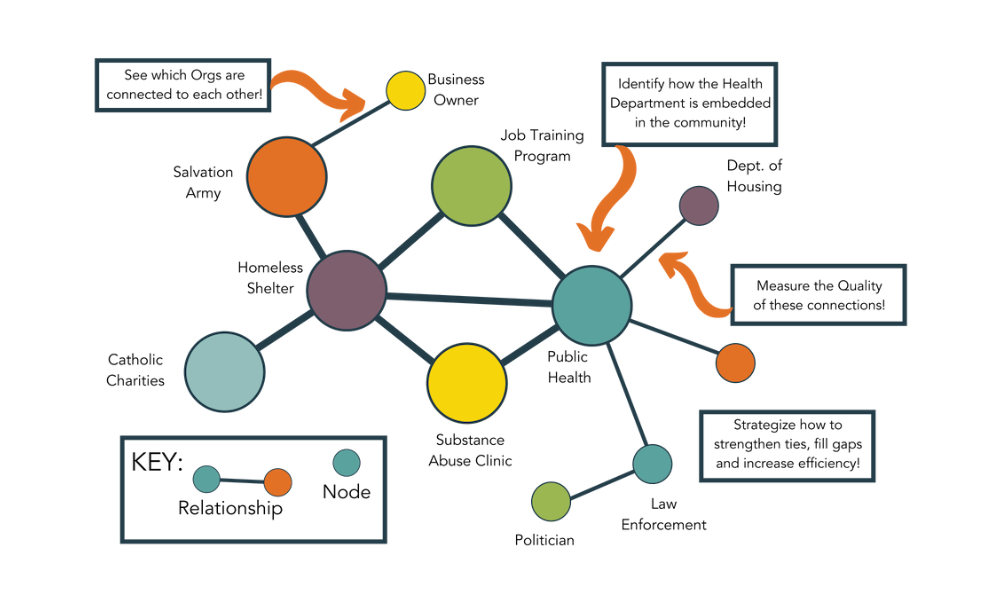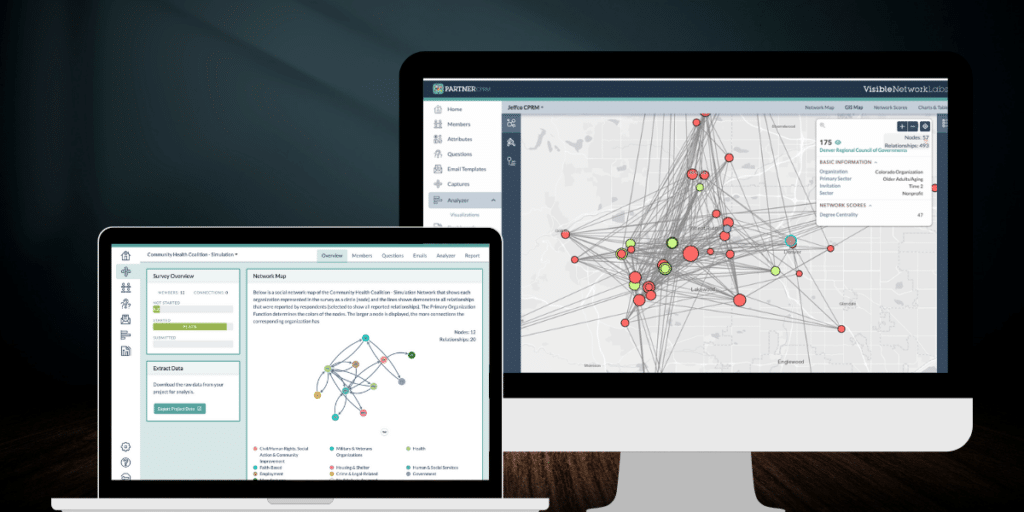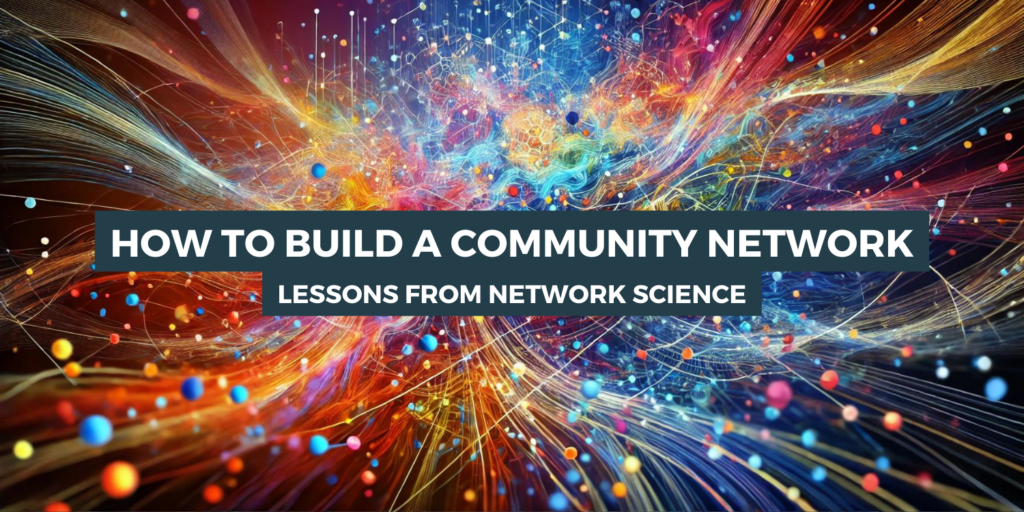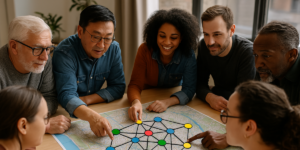Community networks are essential in tackling wide-ranging societal challenges such as public health, education, equity, and environmental sustainability. These networks, which comprise individuals, organizations, and stakeholders, collaborate to spearhead change and implement solutions.
In this article, we’ll introduce some important actionable insights from network science to guide you in creating an effective community network.
Table of Contents
Grasping Network Science
Network science is a fascinating and crucial field that involves the study of various types of networks. These networks encompass a wide range, from social and biological networks to technological systems such as the internet. The essence of network science lies in its ability to dissect the complex web of relationships and interactions that mold these networks.
Understanding the tenets and principles of network science is a vital step in effectively constructing and managing community networks. The application of these principles can greatly enhance the cohesiveness and efficiency of these networks, thereby amplifying their impact and reach.

Diving Deeper into Networks: Nodes and Links
At their core, networks are essentially made up of two primary components: ‘nodes’ and ‘links’. Nodes represent individuals or organizations within a network, while links symbolize the relationships or interactions that exist between these nodes.
In the context of a community network, nodes could represent a variety of entities such as community members, local institutions, non-profit organizations, businesses, or government bodies. Each node, irrespective of its nature, brings unique value and perspective to the network.
Links, on the other hand, could represent various forms of relationships or interactions, ranging from personal relationships, professional collaborations, communication channels, to shared interests or objectives. The strength, frequency, and quality of these links can greatly influence the dynamics and effectiveness of the network.
A successful community network is one that does not merely focus on amassing a large number of nodes but places substantial emphasis on nurturing robust, meaningful, and productive links among these nodes. It’s these relationships that form the backbone of the network, facilitating the flow of information, resources, and support.
The process of fostering strong links involves understanding the needs, interests, and capacities of the nodes, and facilitating opportunities for collaboration. This could involve organizing networking events, facilitating communication and collaboration platforms, or providing resources and support to enhance the quality of interactions.
1. Identifying Key Players
A crucial step in building an effective community network is to identify key participants. This involves leveraging network science concepts. Two such concepts include Centrality Measures and Bridging Connections.
Centrality Measures: In network science, centrality identifies the most influential nodes, which can significantly enhance the network’s effectiveness through their strategic positions. Use centrality measures to pinpoint key stakeholders in your community who can mobilize engagement and recruit others. For example, in a community health initiative, centrality measures could help identify the most connected healthcare providers who could influence public health policies effectively.
Bridging Connections: Nodes that act as bridges between different network clusters can facilitate communication and resource sharing across diverse groups, fostering more innovative and inclusive outcomes.
2. Building Strong Connections
Next, you can begin reaching out to the key players you identified and build new connections and relationships with them. These two network science theories can help you think through this process: the strength of weak ties and reciprocity.
The Strength of Weak Ties: Network science differentiates between ‘strong ties’ (close relationships) and ‘weak ties’ (acquaintances). While strong ties build trust, weak ties introduce new information and opportunities. A balanced approach that nurtures both can expand the network’s reach and diversity.
For example, in a network aimed at improving local education, strong ties might be the close relationships between teachers within the same school who frequently collaborate. These ties build trust and share valuable resources. On the other hand, weak ties could be the connections between these teachers and educators in different schools. While they might not interact as frequently, these can introduce fresh perspectives, innovative methods, or information about different resources, thereby enriching and diversifying the education improvement network.
Creating Reciprocal Relationships: Promote reciprocal relationships where all parties benefit, which builds resilience and trust, essential for long-term network sustainability. Consider all the types of value each partner brings to the table and ensure you are balancing the ‘give’ and ‘take across the network.
3. Optimizing Network Structure
The value of networks come from their interconnected structure. In achieving an optimal network structure, consider the ‘Small World Phenomenon’ and ‘Network Resilience’.
Density and Connectivity: The effectiveness of a network depends on its density (the level of direct ties between nodes) and connectivity. Optimal density ensures efficient information flow without redundancy. For example, a network with low density might try hosting events and activities designed to form more relationships across their members who share similar values or challenges in their work, while a network with high centrality may focus on structuring their connections to work more efficiently across working groups and reduce redundancies.
Modularity: Understanding the natural divisions into modules or clusters within your network can lead to targeted strategies that cater to the unique needs of different groups. For example, you may identify natural groups focused on specific sub-elements of your broader area of focus that can form the basis of working groups. A community health coalition might identify the set of groups working on issues like homelessness, food security, and public health, instead of starting from scratch.
4. Leveraging Technology
There are a number of digital tools and technology that can help you build stronger, more effective networks. Consider a network analysis platform like PARTNER CPRM and digital platforms to facilitate communication and information-shharing.
Network Analysis Tools: Employ tools with social network analysis (SNA) capabilities like PARTNER CPRM to visualize and analyze your network’s structure, helping identify gaps and key influencers. For example, you can map your relationships across a GIS map of the community to identify which neighborhoods are represented in your coalition and were you need to conduct outreach to fill gaps.
Digital Platforms: Use digital platforms to facilitate communication and resource sharing, bridging geographical and temporal gaps, thus enhancing the network’s effectiveness. A CRM with email capabilities or something as simple as a Facebook Group can work for this, based on your specific needs and goals.
5. Measuring Impact
Lastly, develop a process to gather feedback and assess the health of your network relationships. This should be developed based on your network’s unique mission and context to best serve your partners and community.
Network Health Metrics: Regularly check network metrics such as growth, engagement levels, and interaction quality to gauge its health and impact. A network focused on information-sharing might collect data on their engagement levels with partners to measure the quality of their communications.
Feedback Mechanisms: Establish feedback mechanisms for continuous learning and adaptation based on network members’ experiences. These may be digital, paper-based, or face-to-face, depending on the culture and nature of your network.
Building Networks with PARTNER CPRM
PARTNER CPRM is a network analysis tool that provides invaluable insights into the structure and relationships within your community network. It can help you identify key influencers, optimize network structure, leverage technology, and assess the health and impact of your network. With its robust features and user-friendly interface, PARTNER CPRM can empower you to build and manage an effective, resilient community network.

See It Yourself: Request a Demo!
To see how PARTNER CPRM can help you build and manage your community network, we invite you to request a live demo. Our team will guide you through the platform’s capabilities, illustrating how you can apply the principles of network science to create a resilient, impactful community network.
Conclusion
In conclusion, building an effective community network is a multi-faceted process that requires strategic planning, careful execution, and ongoing management. From identifying key players to optimizing the network structure and leveraging technology, each step provides an opportunity to strengthen your network and make a greater impact.
Remember, the goal is not just to grow your network, but to foster meaningful connections that can drive change and create lasting value for your community. With the insights from network science, you can navigate this process more effectively and build a strong, resilient community network.
Looking for more information? Check out our FAQs and resources before to continue your research and learn more about building your community network.
FAQ
Q: Could you define what network science is?
A: Network science is an interdisciplinary field that applies theories and methods from various domains to study a wide array of types of networks. These networks can range from social networks, such as friendship or professional connections, to biological networks, like neural or genetic connections, and technological networks, such as the internet or power grids. The aim is to understand the structure, behavior, and dynamics of these networks, which can lead to insights about how entities interact and function within these networks.
Q: How can I determine who are the key players in my network?
A: One effective way to identify key players in a network is by using centrality measures in network analysis. Centrality measures help determine the individuals or organizations that wield the most significant influence based on their connections within the network. These measures can highlight the most connected individuals, those who broker connections between others, or those who are pivotal in the shortest paths across the network.
Q: Can you elaborate on the benefits of having both strong and weak ties in a network?
A: A balanced mix of strong and weak ties within a network offers several benefits. Strong ties, which are typically characterized by frequent interaction and high levels of trust and collaboration, provide a solid foundation for the network. On the other hand, weak ties, which may be less frequent or intimate, serve as important bridges to new information and opportunities. They can connect different clusters within the network, thus making the network more dynamic, diverse, and resourceful.
Q: Can you explain the significance of network density?
A: Network density is a key metric that affects how information and resources flow within the network. It is defined as the proportion of potential connections in a network that are actually realized. A high-density network means that members are highly interconnected, which can lead to efficient communication and knowledge sharing. However, too high a density can also overwhelm the network and cause information overload. Thus, an optimal level of density ensures effective communication and resource exchange without overwhelming the network members.
Q: How does technology contribute to enhancing community networking?
A: Technology plays a critical role in modern community networking. Especially with the advent of digital platforms and network analysis tools, connectivity within and between communities has been greatly enhanced. These technologies can streamline communication, facilitate resource sharing, and enable more effective collaboration across the network. Moreover, they can also provide valuable insights into the structure and dynamics of the network, which can guide network management and development strategies.
Q: What are the ways to measure the impact of a community network?
A: Measuring the impact of a community network involves assessing various aspects of network health. Key metrics can include growth rate, engagement levels, and the quality of interactions among network members. Regular feedback from network members can also provide valuable insights into the network’s effectiveness and areas for improvement. By monitoring these metrics and feedback, network leaders can measure the impact of the network and guide its ongoing development and improvement.






